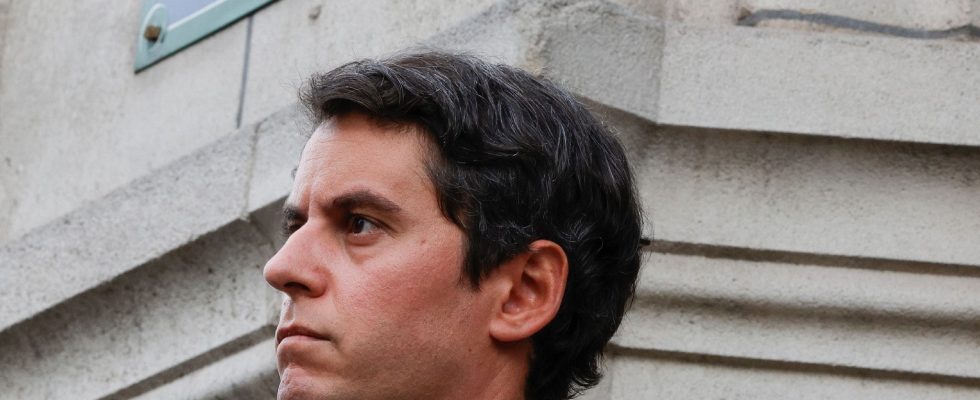The uniform is about to make its big return to school, in the form of an experiment. A novelty which is part of the measures announced by the Minister of National Education Gabriel Attal, on December 5, following the publication of the new OECD Pisa study.
If all the modalities are expected “by the holidays”, as if to keep the candidate cities patient, the Ministry of National Education has sent them a certain number of documents in which it provides details on the implementation concrete work of this “experiment of magnitude”. The calendar is becoming clearer.
Consultations within establishments
The kick-off is planned “from spring 2024” in several cities, including Reims, Perpignan and Metz. The latter “should” have “the possibility of experimenting in a public school” with wearing a uniform, indicated last Thursday, in the municipal council, Anne Stémart, deputy to the mayor (LR) François Grosdidier.
But before the ministry gives its approval, consultations must be carried out in the school council or board of directors. “It’s about not imposing anything”, but “asking the directors […]teachers, parents of students, what is their point of view”, added the mayor of Metz. And to specify that “a first wave” of establishments would do so in France “in February-March”, then “a second in September.
Several candidate cities
In the North, in Denain, the socialist mayor Anne-Lise Dufour is awaiting validation of her candidacy from the Ministry of National Education to “start phase B”, after a consultation has already been held. conducted with parents of students. “In the most favorable school, there were 61% yes, in another more disadvantaged school, 50% yes, 50% no,” she told our colleagues at AFP.
Nice is also among the communities wishing to see the uniform flourish in its classes. Mayor Horizons Christian Estrosi made the request for “four schools”. “We have spoken with the different educational communities of these schools and we are operational to set up this experiment,” Christian Estrosi said in a press release.
Certain municipalities were directly contacted by the ministry to take part in the experiment. This is for example the case of Puteaux (Hauts-de-Seine). The executive is counting on “four schools”, “three for March” and “one in September”.
Free uniform
In establishments subject to the experiment, each student will be provided with a kit consisting of five polo shirts, two sweaters and two pants per child, according to information communicated by the ministry to local authorities.
But good news for families: the cost of the outfit, which amounts to around 200 euros, will be entirely covered by local authorities. They will be able to benefit from “financial support from the Ministry of National Education and Youth”, including in the event of “loss” or “involuntary damage” of the uniform, the documents specify. According to the communities questioned by our colleagues from franceinfo, students will each be entitled to one replacement model per year. Particularly if the uniform no longer fits the child’s size or if it has become worn out.
Compulsory carriage under penalty of penalty
In the establishments involved in the experiment, wearing a uniform will be compulsory for all students, regardless of their class. It must be worn “during any activity linked to teaching which takes place outside their enclosure being registered in the internal regulations”, specifies the documents consulted by our colleagues at BFM TV.
And to warn that any “refusal to wear school uniform will therefore be managed like any breach of the internal regulations of the school or educational establishment”. However, the scope of applicable sanctions was not specified. It is therefore up to the director of the establishment to inflict “a punishment or a sanction depending on the seriousness of the fault”.
Each region has its own uniform
If the outfit should be the same throughout the territory, the uniforms will not all have the same appearance. A necessity much more than a desire to display regional particularities. It is above all a question of adapting to the “meteorological specificities of certain territories”, but also to temperature variations throughout the year “during the winter period or in the event of extreme heat”.
“Implementing the wearing of common clothing involves providing students and their families with a kit whose composition is determined locally and on a case-by-case basis in close collaboration with the local authority and after discussions with the service provider “, says the guide. In addition, the uniform will be subject to change as part of certain courses. Like “physical and sports education” or “professional workshop”.
Experience subject to evaluation
Once the two-year experiment is completed, it will be the objective of an “evaluation”. It will then be a question of measuring “the effects of these experiences on the well-being of students, the school climate, the reduction of social inequalities in academic success and of analyzing the question of the support of families and the modalities of collaboration between the actors concerned. The methods for conducting the evaluation will also be clarified in the coming weeks.
